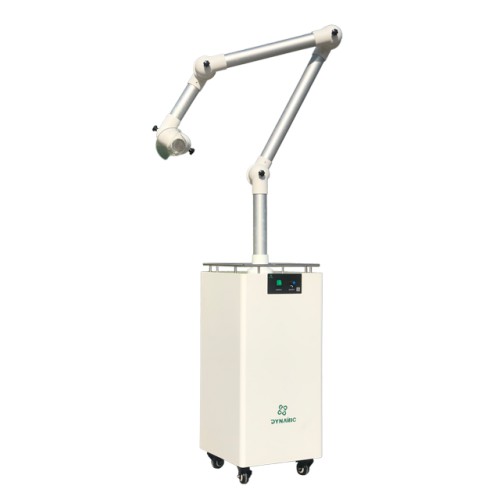Dental care professionals are dangerous exposed to aerosols

Dynamic Extraoral Aerosol Suction Unit External Oral Suction System DS1000
Abstract
Background
Dental care professionals are exposed to aerosols from the oral cavity of patients containing several pathogenic microorganisms. Bioaerosols generated during dental treatment are a potential hazard to dental staff, and there have been growing concerns about their role in transmission of various airborne infections and about reducing the risk of contamination.
Aims
To investigate qualitatively and quantitatively the bacterial and fungal aerosols before and during clinical sessions in two dental offices compared with controls.
Methods
An extra-oral evacuator system was used to measure bacterial and fungal aerosols. Macroscopic and microscopic analysis of bacterial species and fungal strains was performed and strains of bacteria and fungi were identified based on their metabolic properties using biochemical tests.
Results
Thirty-three bioaerosol samples were obtained. Quantitative and qualitative evaluation showed that during treatment, there is a significant increase in airborne concentration of bacteria and fungi. The microflora included mainly gram-positive organisms (Staphylococcus epidermidis and Micrococcus spp.), gram-positive rod-shaped bacteria and those creating endospores as well as non-porous bacteria and mould fungi (Cladosporium and Penicillium).
Conclusions
Exposure to the microorganisms identified is not a significant occupational hazard for dental care professionals; however, evidence-based prevention measures are recommended.
Oral Aerosol Suction Unit is a effective way to avoid aerosols, see more related product at:https://www.dentalsalemall.com/category-238-b0-Oral-Aerosol-Suction-Unit.html
The Advantage of Choosing a Proper Dental Aerosol Suction Unit
Methods to Minimize Dental Aerosol You Should Know About

Dynamic Extraoral Aerosol Suction Unit External Oral Suction System DS1000
Abstract
Background
Dental care professionals are exposed to aerosols from the oral cavity of patients containing several pathogenic microorganisms. Bioaerosols generated during dental treatment are a potential hazard to dental staff, and there have been growing concerns about their role in transmission of various airborne infections and about reducing the risk of contamination.
Aims
To investigate qualitatively and quantitatively the bacterial and fungal aerosols before and during clinical sessions in two dental offices compared with controls.
Methods
An extra-oral evacuator system was used to measure bacterial and fungal aerosols. Macroscopic and microscopic analysis of bacterial species and fungal strains was performed and strains of bacteria and fungi were identified based on their metabolic properties using biochemical tests.
Results
Thirty-three bioaerosol samples were obtained. Quantitative and qualitative evaluation showed that during treatment, there is a significant increase in airborne concentration of bacteria and fungi. The microflora included mainly gram-positive organisms (Staphylococcus epidermidis and Micrococcus spp.), gram-positive rod-shaped bacteria and those creating endospores as well as non-porous bacteria and mould fungi (Cladosporium and Penicillium).
Conclusions
Exposure to the microorganisms identified is not a significant occupational hazard for dental care professionals; however, evidence-based prevention measures are recommended.
Oral Aerosol Suction Unit is a effective way to avoid aerosols, see more related product at:https://www.dentalsalemall.com/category-238-b0-Oral-Aerosol-Suction-Unit.html
The Advantage of Choosing a Proper Dental Aerosol Suction Unit
Methods to Minimize Dental Aerosol You Should Know About


